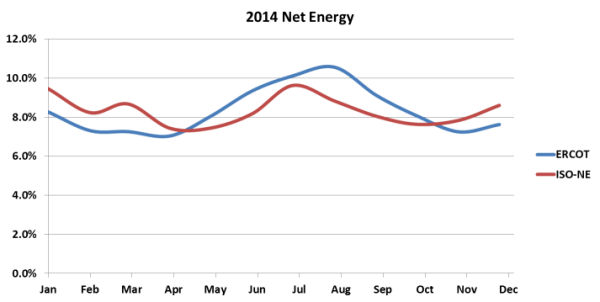Have questions or need help? Give us a call: 1-(888)-364-9259
Regional Electric Usage Patterns and Shopping. Electricity end uses can vary significantly between homes and businesses across the country. Climate control and water heating, however, are consistently the largest end uses among non-industrial electricity customers. To understand regional variations in electricity consumption, it is important to consider both climate and fuel source.
Air conditioning in homes and businesses depends almost entirely on electricity. Space heating fuel sources vary by region and climate. In warmer areas where heating use is moderate, electrical heat pumps and natural gas-fired heating is prevalent. In colder climates, heating oil is more common. Combining fuel source variations with climate differences yields unique electricity consumption patterns.

Sources: ERCOT and ISO New England
The graph above displays monthly electricity usage as percentage of annual electricity usage for ERCOT and ISO-New England. ERCOT is the power grid operator for most of Texas while ISO-New England operates the electrical grid for Connecticut, Massachusetts, Maine, New Hampshire, Rhode Island, and Vermont. Consumption during summer months dominates the Texas electricity profile with almost 40% of annual energy consumption occurring between June and September. New England electricity consumption is more evenly distributed throughout the year with two distinct seasonal usage peaks. In New England, electricity usage in January and July is roughly equal.
These patterns have implications for electricity consumers in both regions. Variable electricity rates can be riskiest during times of peak consumption. While there are some notable exceptions, Texas electricity customers have historically fared well by avoiding variable rate plans during the peak summer season. New England customers can feel the pain of variable rate electricity plans in both winter and summer.
Fixed-rate electricity plans are also influenced by these regional consumption patterns. With variable rate electricity plans no longer available in Connecticut, some electricity providers are offering short-term fixed price plans that extend only until the end of November. These plans are optimized to give a low rate and are based on the seasonal patterns evident in the graph. In Texas, fixed price electricity plans with terms of six or 18 months are designed to exclude the summer peak season or dilute the rate by blending in additional off-peak months.
While odd-term fixed-rate electricity plans are a valid option for many residential and commercial energy customers, it is always good to consider the reasoning behind the offer. If a customer’s contract ends during a peak usage period, the best option may be to select a 12 or 24-month electricity plan to avoid taking a rate hit all at once. The one and two-year electricity offers have a cost-averaging effect and reduce rate shock.
The bottom line is that electricity shoppers should look for savings during peak consumption periods. Short-term rates that apply during months of low energy usage will not be of much help in reducing electricity bills.